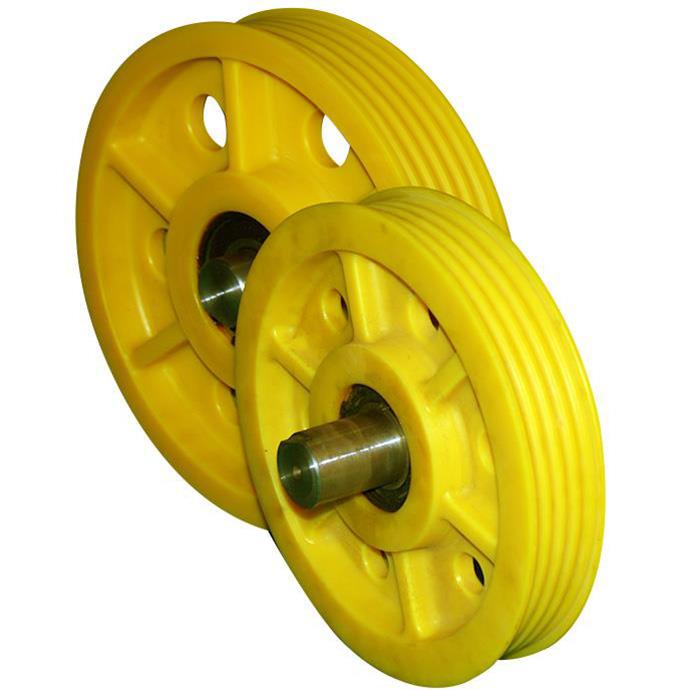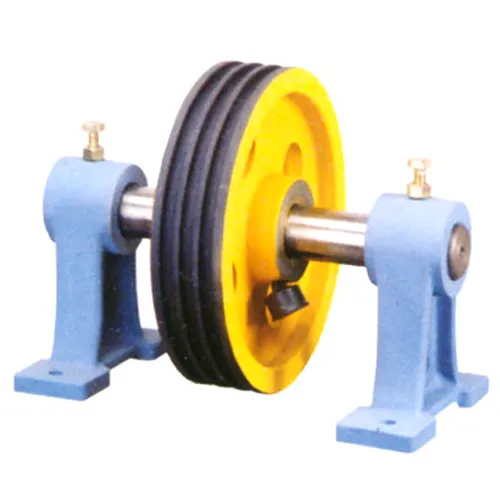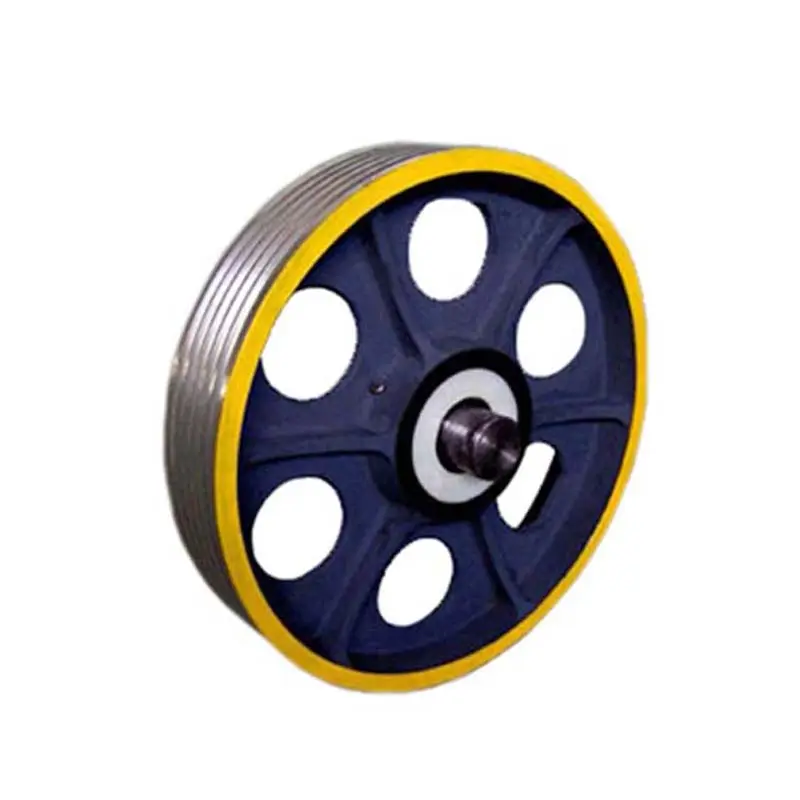Product Description
Professional Custom Mining Lifting Large Cast Iron Wheel Heavy Hoist Sheaves V Belt Pulley
- Materials: gray iron, ductile iron, carbon steel and stainless steel
- Standards: JIS, DIN, ASTM and BS
- We own the CNC machine tools, vertical machining centers, turning center lathes
- Full range of testing equipment besides of CMM
- Product range: casting and machining parts
- Weight: 0.1kg to 50000kg
- Price term: optional
- Processes: sand casting, investment casting, lost foam casting, Precision casting, mold casting, and forging
- Manufacturing equipment: cupola, electric furnace, resin-bonded sanding equipment, dry sand mix miller, quake press molding marching, turning center, hanging shot blast cabinet, heat treatment cellar, vertical machining center, universal milling machine tool, vertical drilling machine tool, and bench drilling
- Testing equipment: elongation tester, hardness tester, metallographic microscope, spectrometer PC, thermometer, CMM, molding sand testing equipment, chemistry composition
Q: What do I need for offering a quote ?
A: Please offer us 2D or 3D drawings (with material, dimension, tolerance, surface treatment and other technical requirement etc.) ,quantity, application or samples. Then we will quote the best price within 24h.
Q: What is your MOQ?
A: MOQ depends on our client’s needs, besides,we welcome trial order before mass-production.
Q: What is the production cycle?
A: It varies a lot depending on product dimension,technical requirements and quantity. We always try to meet customers’ requirement by adjusting our workshop schedule.
Q: What kind of payment terms do you accept?
A.: T/T, L/C, Escrow, Paypal, western union, etc.
Q: Is it possible to know how is my product going on without visiting your company?
A: We will offer a detailed products schedule and send weekly reports with digital pictures and videos which show the machining progress.
| Type: | Clay Dry Sand |
|---|---|
| Casting Method: | Thermal Gravity Casting |
| Sand Core Type: | Resin Sand Core |
| Application: | Machinery Parts |
| Machining: | CNC Machining |
| Material: | Iron |
| Customization: |
Available
| Customized Request |
|---|
How do you select the right lifting pulley configuration for a specific lifting task?
Selecting the right lifting pulley configuration is crucial for ensuring safe and efficient lifting operations. The appropriate pulley configuration depends on various factors related to the lifting task at hand. Here are the key considerations when selecting the right lifting pulley configuration:
1. Load Capacity: Determine the maximum weight or load capacity that needs to be lifted. This information is crucial in selecting lifting pulleys that can handle the expected load without exceeding their safe working load limits.
2. Lifting Method: Consider the lifting method that will be used, such as vertical lifting, horizontal pulling, or a combination of both. Different pulley configurations, such as single sheave, double sheave, or multiple sheave blocks, are suitable for different lifting methods.
3. Pulley Efficiency: Evaluate the efficiency of the pulley system. Look for pulleys with low friction and smooth-running bearings to minimize energy losses and maximize the mechanical advantage provided by the pulley configuration.
4. Space Limitations: Assess the available space for the lifting operation. Depending on the space constraints, you may need to consider compact pulley configurations or alternative lifting methods that require less spatial clearance.
5. Environmental Factors: Consider the environmental conditions in which the lifting task will take place. Factors such as temperature, humidity, and exposure to corrosive substances may influence the choice of pulley materials and coatings to ensure durability and safe operation.
6. Required Precision: Determine the level of precision required for the lifting task. In some applications, such as delicate installations or precise positioning, a pulley configuration that allows for fine adjustments and controlled movement may be necessary.
7. Accessibility: Consider the accessibility of the lifting area. If the lifting task is in a confined or difficult-to-reach space, you may need to choose a pulley configuration that allows for easy installation, adjustment, and removal.
8. Regulatory Compliance: Ensure that the selected lifting pulley configuration complies with relevant safety standards, regulations, and industry guidelines. Adhering to these standards is essential for maintaining a safe working environment and preventing accidents.
9. Expert Advice: When in doubt, consult with lifting equipment specialists or engineers who have expertise in selecting the right pulley configuration for specific lifting tasks. They can provide valuable insights and recommendations based on their experience and knowledge.
By considering these factors and seeking expert advice when needed, you can select the appropriate lifting pulley configuration for a specific lifting task. The right pulley configuration will ensure safe and efficient lifting operations, minimize risks, and optimize performance.
What maintenance procedures are necessary to ensure the safe and reliable operation of lifting pulleys?
Proper maintenance procedures are essential to ensure the safe and reliable operation of lifting pulleys. Regular maintenance helps identify and address potential issues before they escalate, ensuring that the pulleys function optimally and minimize the risk of accidents or equipment failures. Here are some important maintenance procedures for lifting pulleys:
1. Inspection: Regular visual inspections of the pulleys should be conducted to check for any signs of damage, wear, or misalignment. Inspect the sheaves, bearings, mounting hardware, and other components for cracks, deformities, excessive wear, or corrosion. Look for any loose or missing parts that may affect the pulley’s performance.
2. Lubrication: Proper lubrication is crucial for the smooth operation of lifting pulleys. Follow the manufacturer’s recommendations regarding the type and frequency of lubrication. Apply lubricant to the bearings, sheaves, and other moving parts as required. Ensure that the pulleys are adequately lubricated to reduce friction and prevent premature wear.
3. Tension Adjustment: Check the tension of the lifting cable or rope regularly. The cable or rope should be properly tensioned to prevent slippage or excessive stress on the pulleys. Adjust the tension as needed according to the manufacturer’s guidelines or industry standards.
4. Cleaning: Keep the pulleys clean and free from dirt, debris, or contaminants that could interfere with their proper operation. Use a brush or compressed air to remove any buildup or foreign particles. Avoid using harsh chemicals or solvents that may damage the pulley’s components.
5. Replacement of Worn or Damaged Parts: If any component of the pulley, such as the sheaves, bearings, or mounting hardware, is worn, damaged, or showing signs of deterioration, it should be promptly replaced with suitable replacements recommended by the manufacturer. Use genuine parts to ensure compatibility and maintain the pulley’s performance.
6. Periodic Load Testing: Periodically conduct load testing of the lifting system to ensure the pulleys can handle the intended load capacity. Follow industry standards and guidelines for load testing procedures. This testing helps verify that the pulleys and associated components can safely support and lift the specified loads.
7. Training and Operator Awareness: Ensure that operators are trained in proper lifting procedures, including the use and maintenance of lifting pulleys. Educate them about the importance of regular maintenance, inspection, and safe operating practices. Encourage operators to report any abnormalities or concerns regarding the pulleys to the maintenance personnel or supervisor.
It is crucial to follow the manufacturer’s recommendations and guidelines for maintenance procedures specific to the lifting pulleys in use. Additionally, adhere to any applicable industry standards and regulations governing the maintenance of lifting equipment. By implementing regular maintenance procedures, operators can promote the safe and reliable operation of lifting pulleys, prolong their service life, and minimize the risk of accidents or equipment failures.
In which industries and tasks are lifting pulleys commonly used for material handling?
Lifting pulleys are commonly used for material handling in various industries and tasks. Here are some examples:
1. Construction: In the construction industry, lifting pulleys are used for hoisting and moving heavy construction materials, such as steel beams, concrete blocks, and scaffolding components. They are employed in cranes, hoists, and other lifting equipment to facilitate the vertical and horizontal movement of materials at construction sites.
2. Manufacturing: Lifting pulleys play a crucial role in manufacturing facilities for material handling tasks. They are used in assembly lines, warehouses, and distribution centers to lift and transport raw materials, components, and finished products. Lifting pulleys are often integrated into conveyor systems, overhead cranes, and lifting devices to streamline the movement of materials throughout the manufacturing process.
3. Shipping and Logistics: In the shipping and logistics industry, lifting pulleys are utilized for loading and unloading cargo from ships, trucks, and airplanes. They are employed in cranes, gantries, forklifts, and other material handling equipment to efficiently move containers, pallets, and packages within ports, warehouses, and transportation hubs.
4. Mining and Quarrying: Lifting pulleys are essential in mining and quarrying operations for extracting and transporting minerals, ores, and aggregates. They are used in conveyor systems and mining equipment to lift and transfer heavy loads, such as rocks, coal, and bulk materials. Lifting pulleys in mining applications are designed to withstand harsh environments and heavy-duty usage.
5. Agriculture: Lifting pulleys find application in the agricultural industry for material handling tasks. They are used in farming operations to lift and move bales of hay, bags of feed, and agricultural equipment. Lifting pulleys are often integrated into tractor-mounted loaders, barn hoists, and other agricultural machinery to assist in the handling of various farm materials.
6. Warehousing and Distribution: In warehousing and distribution centers, lifting pulleys are extensively used for material handling tasks. They are employed in forklifts, pallet jacks, and automated storage and retrieval systems to lift and transport goods within the facility. Lifting pulleys enable efficient loading and unloading of palletized and packaged products, optimizing the flow of materials in the supply chain.
Lifting pulleys are versatile tools that are widely employed in industries where material handling is a critical aspect of operations. From construction and manufacturing to shipping and logistics, mining and quarrying, agriculture, and warehousing, lifting pulleys enhance efficiency and safety in the movement of materials across various sectors.
editor by CX
2023-11-13




